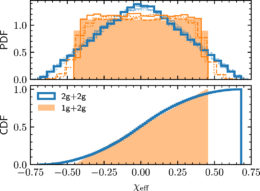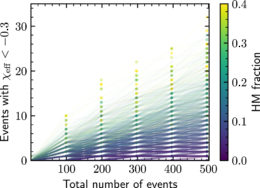Astronomers study gravitationally linked pairs of black holes to understand how stellar-mass black holes form. What can we learn from black holes that are off kilter from the binaries they belong to?
You Spin Your Way, and I’ll Spin Mine

Top: The black hole spins are aligned with the system’s orbital angular momentum (positive χeff). Bottom: The black hole spins are misaligned with the system’s orbital angular momentum (negative χeff). [Kerry Hensley]
One property we can use to probe the origins of black holes in merging binary systems is the effective inspiral spin parameter, denoted χeff, which is a measure of how aligned the spins of the black holes are with the orbit of the binary pair. In some systems, the black holes spin in the same direction as they orbit, giving the system positive χeff. In others, one or both black holes are tilted, and they spin in directions that are at odds with their orbital motion, giving the system negative χeff. A recent publication searches for the most misaligned black hole binaries to understand the origins of the black holes in the universe today.

Theoretical probability distribution functions (top) and cumulative distribution functions (bottom) for the effective inspiral spin parameters (χeff) of binary systems containing one (orange) or two (blue) black holes formed through hierarchical merging. The different lines in the top panel show the effect of different initial black hole spins. [Fishbach et al. 2022]
Monitoring Misalignment
Maya Fishbach (Northwestern University) and collaborators began their investigation by predicting the spins of black holes in binaries in which at least one member formed through hierarchical merging. The team’s calculations showed that hierarchical merging results in a substantial number of black holes with spins misaligned from their direction of orbital motion. Specifically, the team predicted that 16% of black hole binaries would have χeff less than −0.3, regardless of whether one or both members of the binary system arose through hierarchical merging.
With this prediction in hand, Fishbach and coauthors turned to the data, assessing the χeff values of 69 merging black hole pairs in the third Gravitational-wave Transient Catalog (GWTC-3), which is the most recent catalog of gravitational wave events detected by LIGO and Virgo. Depending on the model used to analyze the data, the team found that the maximum proportion of binary systems with χeff less than −0.3 is 4.2%.
Evidence for Meager Mergers

The expected number of gravitational wave events for systems with χeff less than −0.3 that we expect to observe as a function of the hierarchical merger (HM) fraction and the total number of events observed. [Fishbach et al. 2022]
Fishbach and collaborators note that if black hole binaries with χeff less than −0.3 aren’t detected in the future, that would point to hierarchical merging being even less common. If the LIGO, Virgo, and KAGRA gravitational wave detectors find no such systems during their next observing runs, the team limits the percentage of black holes formed through hierarchical merging to no more than 2.5%.
Citation
“Limits on Hierarchical Black Hole Mergers from the Most Negative χeff Systems,” Maya Fishbach et al 2022 ApJL 935 L26. doi:10.3847/2041-8213/ac86c4

